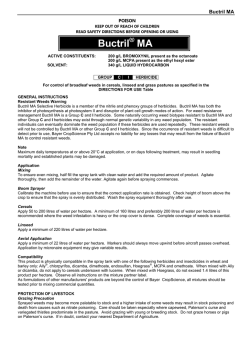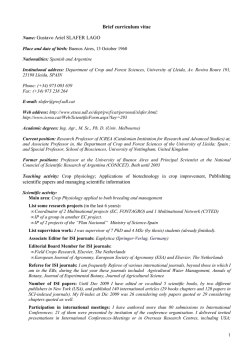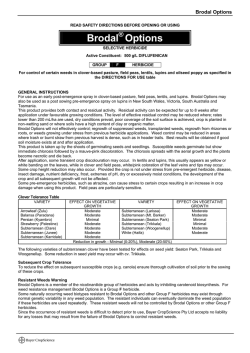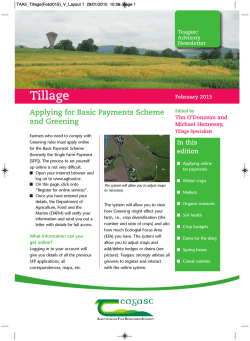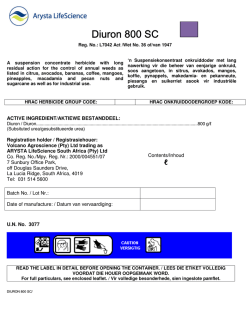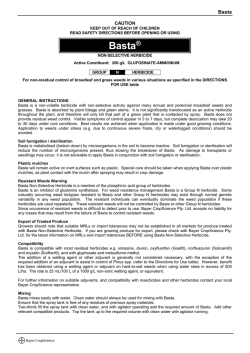
Sencor® 480 SC - Bayer CropScience
Sencor 480 SC POISON KEEP OUT OF REACH OF CHILDREN READ SAFETY DIRECTIONS BEFORE OPENING OR USING Sencor® 480 SC SELECTIVE HERBICIDE Active Constituent: 480 g/L METRIBUZIN GROUP C HERBICIDE For selective weed control in various broadacre and vegetable crops as indicated in the DIRECTIONS FOR USE table GENERAL INSTRUCTIONS Sencor is effective against a range of broadleaf weeds and some grasses. Sencor is absorbed by roots, shoots and leaves of weeds. It can therefore be applied before or after weeds emerge depending on the tolerance of the crop being treated. For recently introduced varieties DO NOT use Sencor unless it is ascertained that the variety to be treated shows sufficient tolerance to the treatment under local climatic conditions. Crop Safety The use of other herbicides and/or crop oils on broadleaf crops treated with Sencor may cause severe damage. Before using Sencor 480 SC on newly released crop varieties, confirm the variety tolerance with the State Department of Agriculture, Agronomist or Bayer CropScience representative. Resistant Weeds Warning Sencor is a member of the triazinone group of herbicides and has the inhibitor of photosynthesis at photosystem II mode of action. For weed resistance management the product is a Group C herbicide. Some naturally-occurring weed biotypes resistant to the product and other Group C herbicides may exist through normal genetic variability in any weed population. The resistant individuals can eventually dominate the weed population if these herbicides are used repeatedly. These resistant weeds will not be controlled by the product or other Group C herbicides. Annual ryegrass biotypes resistant to diclofop-methyl and other ‘grass specific’ herbicides are often also resistant to Sencor 480 SC. Before using Sencor 480 SC on a population resistant to ‘grass specific’ herbicides, have a resistance test conducted to ensure that it is still susceptible to Sencor 480 SC. Since the occurrence of resistant weeds is difficult to detect prior to use, Bayer CropScience Pty Ltd accepts no liability for any losses that may result from the failure of the product to control resistant weeds. Large numbers of healthy surviving weeds can be an indication that resistance is developing. Efforts should be made to prevent seed set of the survivors. DO NOT make more than one application of a Group C herbicide to a crop in the same season, either pre-sowing incorporated by sowing or post crop and weed emergence. If the user suspects that a Group C resistant weed is present, Sencor 480 SC or other Group C herbicides should not be used. Strategies to minimise the risk of herbicide resistance are available. Consult your farm chemical supplier, consultant, local Department of Agriculture or Primary Industries, or local Bayer CropScience representative. Export of Treated Produce Growers should note that MRLs or import tolerances do not exist in all markets for edible produce treated with Sencor 480 SC Selective Herbicide. If you are growing edible produce for export, please check with Bayer CropScience Pty Ltd for the latest information on MRLs and import tolerances before using Sencor 480 SC Selective Herbicide. Compatibility Sencor 480 SC is compatible with the insecticides Nitofol® on potatoes, Le-mat® on peas, Dominex® Duo and Talstar® 100 EC. Sencor 480 SC is compatible with the herbicides Trifluralin, Glean®, Ally®, Brodal® Options, Buctril® MA, Jaguar®, Simazine, Stomp®, Tigrex® and Yield®. DO NOT mix concentrates together but add each to the spray tank separately. As formulations of other manufacturers' products are beyond the control of Bayer CropScience Pty Ltd, all mixtures should be tested prior to mixing commercial quantities. As changes in climatic conditions can alter the sensitivity of plants to mixtures of sprays, Bayer CropScience cannot be responsible for the behaviour of such mixtures. Mixing Prior to pouring, shake container vigorously for at least 30 seconds, then add the required quantity of Sencor to the required amount of water and stir. Rinse empty container with water and pour into spray tank. Keep agitators in motion. Sencor 480 SC Application General Best results are obtained if treatment is made to moist soil and moisture is supplied by rainfall or sprinkler irrigation (6-12 mm) within 2 weeks after application. If heavy rains occur soon after application, injury to the crop may result. Pre-emergence Soil should preferably be moist to the surface and must not be cloddy or have residues of a previous crop on the surface. It is better to delay pre-emergence spraying of loose or fluffy soils until there is a good soil settling rain. Rain or irrigation soon after spraying is required to activate Sencor. Post-emergence Post-emergence spraying will control young actively growing emerged weeds through leaf uptake. Subsequent preemergence control of later germinating weeds requires rain or irrigation after spraying. Crops may show slight chlorosis or necrosis after spraying. Two sunny days before spraying enhances crop tolerance. Heavy rain (80-100 mm) after spraying on deep sandy or friable well structured soils may leach Sencor beyond the root zone thus reducing residual effect. Ground Spraying Apply Sencor through a carefully calibrated boom spray set at 200 to 300 kPa pressure (except for tomatoes in Qld only) fitted with fan nozzles. Use a convenient quantity of water (50-100 L/ha). Cone nozzles and other means of application are not satisfactory and should not be used. When spraying avoid over-lapping and shut off spray booms while starting, turning slowly and when stopped. Neglecting these procedures will cause higher rates of application resulting in crop damage. Delay post-emergence spraying if rain is expected within a few hours. Aerial Spraying Wind: Spray only in crosswinds, otherwise uneven coverage may result. DO NOT spray onto inversions or in dead calm conditions. DO NOT spray when winds are light and variable in direction unless smoke indicators or the spray cloud show that the spray is going down into the crop. Spray drift may damage adjoining crops. Make sure that the wind is blowing away from crops for which Sencor is not recommended. Flying: Fly with the wheels 2 to 3 metres above the crop as "wheels on crop" spraying causes uneven distribution. Track spacing must be uniform and suited to the type of aircraft and crosswind speed. Droplet Size: For grasses and vertical weeds, use fine droplets. For horizontal weeds and drift limitation, use droplets over 200 microns and increase volume. Water Volume: Use 20 to 30 L water/ha. PROTECTION OF CROPS, NATIVE AND NON-TARGET PLANTS Prevent drift of spray to sensitive plants. Keep from contact with fertilisers, insecticides, fungicides and seeds. Thoroughly clean all traces of Sencor from application equipment immediately after use. To minimise risk to follow-on sensitive crops such as beetroot, brassicas, capsicums, cotton, cucurbits, lettuce, onions and sunflowers, it is advisable to work land thoroughly - allow at least 6 months (12 months for cucurbits) between application of Sencor 480 SC and sowing seed of these sensitive crops. A longer period may be required following long dry periods between crops. If rates of Sencor 480 SC higher than 1.5 L/ha were used, allow at least 12 months before planting these crops. The use of other herbicides and/or crop oils on broadleaf crops treated with Sencor 480 SC may cause severe damage. DO NOT apply under weather conditions, or from spraying equipment, that may cause spray to drift onto nearby susceptible plants/crops, cropping lands or pastures. PROTECTION OF WILDLIFE, FISH, CRUSTACEANS AND ENVIRONMENT Dangerous to aquatic organisms. DO NOT contaminate streams, rivers or waterways with the chemical or used containers. STORAGE AND DISPOSAL Store in the closed, original container in a cool, well-ventilated area. Do not store for prolonged periods in direct sunlight. Triple or preferably pressure rinse containers before disposal. Add rinsings to spray tank. Do not dispose of undiluted chemicals on site. If recycling, replace cap and return clean containers to recycler or designated collection point. If not recycling, break, crush, or puncture and deliver empty packaging to an approved waste management facility. DO NOT burn empty containers or product. DO NOT re-use empty containers for any other purpose. SAFETY DIRECTIONS Harmful if swallowed. Avoid inhaling spray mist. Wash hands after use. FIRST AID If poisoning occurs, contact a doctor or Poisons Information Centre (telephone 13 11 26). Sencor 480 SC MATERIAL SAFETY DATA SHEET Additional information is listed in the Material Safety Data Sheet, which can be obtained from www.bayercropscience.com.au. EXCLUSION OF LIABILITY This product must be used strictly as directed, and in accordance with all instructions appearing on the label and in other reference material. So far as it is lawfully able to do so, Bayer CropScience Pty Ltd accepts no liability or responsibility for loss or damage arising from failure to follow such directions and instructions. Brodal, Buctril®, Jaguar®, Nitofol, Sencor and Tigrex® are Registered Trademarks of Bayer. Le-mat® is a Registered Trademark licensed to Bayer. FOR 24 HOUR SPECIALIST ADVICE IN EMERGENCY ONLY PHONE 1800 033 111 APVMA Approval No: 31791/0509 DIRECTIONS FOR USE Restraints DO NOT apply until soil is well wetted by the first good soil settling rain after sowing. DO NOT spray plants under stress from drought, waterlogging, frost or disease. DO NOT allow spray mix to stand overnight. CROP/ SITUATION Asparagus WEEDS STATE RATE CRITICAL COMMENTS False castor oil (thornapples), shepherd's purse, fat hen Qld, NSW, ACT, Vic, Tas, SA only 1.1 or 2.2 L/ha Winter weed control: Chickweed, shepherd's purse, nettle, deadnettle WA only 0.8 or 1.5 L/ha Direct seeded asparagus Apply to moist soil as soon as possible after sowing before crop emerges and overhead irrigate. A follow up application may be required 4-8 weeks later for emerged weeds. DO NOT spray until asparagus seedlings are at least 4 cm high. Some temporary burning may occur. Use the higher rate on heavier soils. Seedling asparagus (transplanted) DO NOT spray before asparagus seedlings are 4 cm high and seedlings have been well established after transplanting. Spray when weeds have emerged when young and actively growing. Use the higher rate on older weeds. Established asparagus in beds Apply immediately after transplanting crowns or preparing beds for cutting and before spears emerge, or after cutting for the season is finished. Overhead irrigate within a few days after spraying. Use the higher rate on heavier soils. Spring and summer weed control: False castor oil (thornapples), shepherd's purse, fat hen Sencor 480 SC CROP/ SITUATION Barley Postemergent application Barley (except Morrell and Harrington) WEEDS STATE RATE Controlled: seedlings of: capeweed, catsear, charlock, chickweed, common cotula, corn gromwell (sheepweed, white ironweed), corn spurry, creeping speedwell, crown beard (dogweed), deadnettle, dock, fat hen, field madder, fumitory, hare's ear (treacle mustard), heliotrope, hogweed (wireweed), horehound, Indian hedge mustard, lesser swinecress, mouse-ear chickweed, mountain sorrel (purple calandrinia), rough poppy, scarlet pimpernel, scrub nettle (stinging nettle), shepherd's purse, sorrel, sowthistle, spiny emex (threecornered jacks), storksbill, toad rush, wild radish, wild turnip, winter grass, yellow burrweed Vic, Tas, SA only 280 mL/ha (Light sandy soils i.e. sandy loam to loamy sands) Suppressed: Annual ryegrass, sub clover Buxbaum's speedwell, Powell's amaranth, stagger weed, sun spurge, great brome Buchan weed, fog grass Capeweed, doublegee, geranium, mustard, toad rush, turnip, wild radish, wireweed Pre-sowing or incorporated by sowing Supressed: Annual ryegrass, barley grass, brome grass Chickpeas Controlled: as per Barley (Vic, SA, Tas) Buchan weed, fog grass (SA only) Faba beans Suppressed: Sub clover Lentils 435 mL/ha (Medium soils, loams. Silt plus clay content 40 to 60%) 580 mL/ha (Heavy soils, clay loams. Silt plus clay content over 60%) CRITICAL COMMENTS DO NOT spray before barley is at 3 leaf stage or later than 8 weeks after sowing. Application of this product on alkaline sandy soils (pH greater than 7) will result in severe crop damage. In Tasmania, DO NOT use Sencor on barley grown on sandy soils. For effective wild radish, wireweed and ryegrass control, the weed must have emerged before Sencor application. Wireweed in the cotyledon stage and annual ryegrass with no more than 2 leaves can be controlled provided rain follows within a few days of spraying. Emerged weeds must be young and actively growing. Tas only SA only WA – Great Northern region only Southern NSW, ACT, Vic, SA, WA only NSW, ACT, Vic, SA, WA only Vic, SA, WA only 210 – 235 mL/ha + 1 L/ha Trifluralin 280 mL/ha (Light sandy soils i.e. sandy loam to loamy sands) 435 mL/ha (Medium soils, loams. Silt plus clay content 40 to 60%) 580 mL/ha (Heavy soils, clay loams. Silt plus clay content over 60%) 1. Correct application and incorporation techniques are critical to obtain optimum performance of Sencor and Trifluralin mixtures. ENSURE all recommendations on the Trifluralin label are followed. 2. Use the lower rate in lighter soils, and the higher rate in heavier soils. 3. Application of this product on alkaline sandy soils (pH greater than 7) will result in severe crop damage. 4. Apply to moist soil for best efficacy. 5. Seed below herbicide band at 5 cm. 6. Reduced control may occur under high weed burdens (> 100/m2). 7. The performance of Sencor and Trifluralin mixtures in terms of crop tolerance and weed control may vary according to climate, soil and crop conditions. This treatment should only be used where no alternatives are available. ONLY apply post sowing, pre-emergence. Crops should be sown at least 5 cm deep. DO NOT apply post-emergence, as crop injury will occur. DO NOT apply to chickpeas grown on sandy soils, i.e. silt plus clay less than 40%. The vigour of lentils may be reduced, especially if heavy rain falls after spraying. Weeds should be from pre-emergence to 3 leaf stage except wireweed (hogweed) which should not be beyond the cotyledon stage. Best results for grass and wireweed control are obtained when rain or irrigation follows within a few days of spraying. DO NOT apply by aircraft to chickpeas and faba beans. Sencor 480 SC CROP/ SITUATION Lupins (except Danja, Kiev Mutant, Tanjil, Wonga, Belara, Chitick, Moonah, Quilinock, Woodjil or Albus lupins) WEEDS For control of wild radish up to 250 mm diameter. For suppression of capeweed, doublegee, and larger wild radish. Use higher rate for larger weeds. Oats Toad rush Peas (field, processing, green) Controlled: as per Barley (Vic, SA, Tas) DO NOT use on Laura, Pennant or White Brunswick varieties Suppressed: Annual ryegrass, sub clover Buxbaum's speedwell, Powell's amaranth, stagger weed, sun spurge Buchan weed, fog grass STATE RATE WA – Great Northern region ONLY 160 to 235 mL/ha plus 100 mL Brodal Options CRITICAL COMMENTS 1. 2. 3. Sencor should only be used following a pre-sowing treatment of Simazine. DO NOT apply to alkaline soils with pH > 7. Apply to actively growing lupins from the 3-4 leaf stage onwards. 4. DO NOT apply to weeds or crop which are under stress. 5. Apply to moist soil for best efficacy. 6. Use higher rates for heavy weed burden and larger weed size. Apply before weeds are covered by crop canopy. 7. Best results are obtained if good soil moisture exists at, and received soon after application. 8. DO NOT apply wetting agents, spray oils or grass selective herbicides with the Sencor + Brodal Options mixture. 9. Transient crop yellowing and burning may become evident after application. This effect is short term and will not normally reduce lupin yield. 10. Refer to Critical Comments section on the Brodal Options label. Vic only 150 mL/ha Qld, NSW, ACT, Vic, Tas, SA only 280 mL/ha (Light sandy soils i.e. sandy loam to loamy sands) Tas only SA only 435 mL/ha (Medium soils, loams. Silt plus clay content 40 to 60%) 580 mL/ha (Heavy soils, clay loams. Silt plus clay content over 60%) 730 mL/ha (Koo-wee-rup swamp and volcanic soils) IMPORTANT The performance of Sencor in terms of crop tolerance and weed control may vary with varying climate, soil and crop conditions. This treatment should only be used where no alternatives are available. Toad rush should be sprayed at the 2-4 leaf stage for optimum control. Spray after rain when soil moisture is plentiful and soil is moist to the surface. Take advantage of dew on soil surface. Pea crops should be sprayed pre-emergence or early post-emergence of crop and/or weeds, but within 6 weeks after sowing (and not later than 8 weeks in Victorian winter crops). Peas must not be beyond the 3 node stage. DO NOT treat peas post-emergence in areas or soils where collar rot, stem rot or black spot are present or are likely to occur. In Tasmania, DO NOT use Sencor on field peas grown on light sandy soils. DO NOT spray Cressy Blue peas post-emergence. Some other varieties, e.g. Dundale and Wirrega, may be especially sensitive to Sencor. DO NOT use on a large scale unless it has been ascertained that the variety shows sufficient tolerance under local conditions For effective wild radish, wireweed and ryegrass control, the weed must have emerged before Sencor application. Wireweed in the cotyledon stage and annual ryegrass with no more than 2 leaves can be controlled provided rain follows within a few days of spraying. Emerged weeds must be young and actively growing. Sencor 480 SC CROP / SITUATION WEEDS Pigeon peas Apple of Peru, bladder ketmia, gooseberry, Noogoora burr, cowvine (peach vine), volunteer cotton, yellow vine, false castor oil (thornapples) Potatoes Some varieties such as Atlantic and red skin varieties are especially sensitive to Sencor. Damage may occur even at the lowest label rate. DO NOT use on Kurell or Bison potatoes. Controlled: as per Barley (Vic, SA, Tas) STATE RATE Qld, NSW, ACT only except sandy soils 750 mL/ha All States 730 mL/ha or 1.1 L/ha Vic - Bellarine Peninsula only 430 to 580 mL/ha (winter) Qld - Atherton Tableland ONLY 730 mL/ha for winter crops Suppressed: Annual ryegrass, dock, sub clover, summer grasses (Digitaria spp.) 1.45 L/ha for summer crops CRITICAL COMMENTS Rain grown and overhead irrigated crops: Apply immediately after or within a day or two after sowing before crops emerge then irrigate. Otherwise rain after spraying before weeds emerge is necessary to get useful weed control. The longer the time interval between spraying and rain or irrigation the less the effectiveness of the herbicide. Sencor can be applied to a band centred on crop rows for in-row weed control. Untreated soil between treated bands thrown onto treated areas during subsequent cultivation will reduce weed control along rows. Sencor can be applied after pre-sowing Trifluralin treatment. Avoid leaving a depression over the row during planting to enhance crop tolerance. Furrow irrigated crops: Apply after furrowing out and within two weeks before sowing and incorporate with Lillistone cultivators to finely tilled soil free of emerged weeds. Where grass weeds are expected, add Trifluralin at the rate recommended by the manufacturer for the soil type. For postemergence weed control: Apply when weeds are in the young seedling stage and actively growing, provided crop plants have at least 2-trifoliate leaves. DO NOT spray if rain is likely to fall within several hours. Transitory damage may occur to the pigeon pea crop but yields will not be significantly affected. Spray when potatoes are emerging with the largest shoots not more than 10 cm tall. Use higher rate for emerging summer grasses. In summer crops on soils which dry rapidly on the surface, the young actively growing weeds will be killed but residual effect may be reduced. If there is a subsequent germination of weeds apply a second spray at 730 mL/ha (except NSW). DO NOT use Sencor in Western Australia in the Perth metropolitan area; on the south west winter potato crops; or on Delaware potatoes on light soils. Potatoes may be hilled before or after spraying Sencor. If hilled after spraying a good rain or irrigation is desirable between spraying and hilling. No other cultivation should be necessary. Use higher rate for emerging summer grasses. Hill up the crop soon after planting. Irrigate to allow weed seeds to germinate and potatoes to begin emerging. Apply as an overall spray to a soil moist to the surface, before all the crop has emerged. Sencor 480 SC CROP/ SITUATION Soybeans in soils of pH 9 or lower DO NOT use on Cannapolis, Hill, Semstar or Triton varieties Tomatoes Transplanted tomatoes Vetch WEEDS Apple of Peru, bladder ketmia, cowvine (peach vine), gooseberry, Noogoora burr, volunteer cotton STATE RATE CRITICAL COMMENTS NSW clay soils in NW only, Qld clay soils on Darling Downs only 750 mL/ha Qld, NT only 1.45 L/ha (15 mL/100 m of row) Rain grown and overhead irrigated crops: Apply immediately after or within a day or two after sowing before crops emerge then irrigate. Otherwise rain after spraying before weeds emerge is necessary to get useful weed control. The longer the time interval between spraying and rain or irrigation the less the effectiveness of the herbicide. Sencor can be applied to a band centred on crop rows for in-row weed control. Untreated soil between treated bands thrown onto treated areas during subsequent cultivation will reduce weed control along rows. Sencor can be applied after pre-sowing Trifluralin treatment. Avoid leaving a depression over the row during planting to enhance crop tolerance. Furrow irrigated crops: Apply after furrowing out and within two weeks before sowing and incorporate with Lillistone cultivators to finely tilled soil free of emerged weeds. Where grass weeds are expected, add Trifluralin at the rate recommended by the manufacturer for the soil type. DO NOT use on cv Triton as crop damage may occur. Apply in a 1 metre wide band centred on the interrow either during or shortly after the formation of the final irrigation furrow. Apply to soil moist to the surface. Apply through applicators fitted with flat fan nozzles and operated at pressures not exceeding 200 kPa to avoid misting and spray drift. Controlled: As per Barley (Vic, SA, Tas) plus barnyard grass, bull's head, crowsfoot grass, nightshade, pigweed, black pigweed, summer grass, green summer grass Apple of Peru, potato weed NSW, ACT only 750 mL - 1.2 L/ha Controlled: as per Barley (Vic, SA, Tas) Vic, SA, WA only 280 mL/ha (Light sandy soils i.e. sandy loam to loamy sands) 435 mL/ha (Medium soils, loams. Silt plus clay content 40 to 60%) 580 mL/ha (Heavy soils, clay loams. Silt plus clay content over 60%) DO NOT follow autumn plantings of tomatoes with cucurbits or capsicums in the same season. Apply as a directed spray to weeds at the base of tomato plants. Use the lower rate when tomatoes have 4-5 expanded leaves or the higher rate when tomatoes beyond this stage and weeds are well established. Accurately calibrated spray equipment, fitted with one flat fan 80° even spray Teejet nozzle operated to deliver 100 to 200 L of spray per hectare and angled to avoid tomato leaves should be used. DO NOT apply during or soon after prolonged periods of overcast or cloudy weather. Allow at least two fine, sunny days before spraying. Spray on a sunny fine day. Suppression of other broadleaf weeds such as false castor oil may occur. Crop: Only apply post sowing pre-emergence. Crop should be sown at least 5 cm deep. The vigour of vetch may be reduced, especially if heavy rain falls after spraying. Do not apply post-emergence, as crop injury will result. Weeds: Weeds should be from pre-emergence to 3 leaf stage except wireweed (hogweed) which should not be beyond the cotyledon stage. Best results for grass and wireweed control are obtained when rain or irrigation follows within a few days of spraying. Sencor 480 SC CROP/ SITUATION Wheat Postemergent application only Wheat (Blade & Eagle Rock only) Pre-sowing or incorporate d by sowing WEEDS STATE RATE CRITICAL COMMENTS Toad rush NSW, ACT, Vic, SA only 150 mL/ha Toad rush should be sprayed at the 2-4 leaf stage for optimum control. Spray after rain when soil moisture is plentiful and soil is moist to the surface. Take advantage of dew on soil surface. Capeweed, common cotula, doublegee, fumitory, Indian hedge mustard, toad rush, wild turnip, wild radish, wireweed WA – Great Northern region only 310 mL/ha 1. Sencor 480 SC has increased crop safety and gives more reliable weed control when incorporated by sowing and trailing harrows. 2. DO NOT apply to alkaline soils with pH > 7. 3. Apply to moist soil for best efficacy. 4. Seed below herbicide band at 5 cm. 5. Reduced control may occur under high weed burdens (> 100/m2). 6. To improve control of annual ryegrass and barley grass add Trifluralin at 1 L/ha. 7. Ensure Sencor 480 SC is fully dispersed in the boom spray tank prior to Trifluralin addition. 8. The performance of Sencor and Trifluralin mixtures in terms of crop tolerance and weed control may vary according to climate, soil and crop conditions. This treatment should only be used where no alternatives are available. Suppressed: Brome grass (Bromus diandrus & B. rigidus) Sandy – sandy loam soils Annual ryegrass, barley grass, geranium 310 mL/ha + 1 L/ha Trifluralin 9. White lupins Buchan weed, capeweed, charlock, Chickweed, Deadnettle (Lamium spp.) fat hen, fumitory (common and wall fumitory – Tas), wireweed (hogweed), lesser swinecress, purple calandrinia, scarlet pimpernel, spiny emex, corn spurry (spurry - Tas), stinging nettle (dwarf nettle - Tas), toad rush, winter grass, heliotrope, wild oats, wild radish, wild turnip Suppression only: Sub clover and docks (broadleaf dock - Tas) Tas only 625 mL/ha Refer to the Application section of this and the Trifluralin label for complete instructions on product use. Spring application. Apply after sowing but before crop emerges. NOT TO BE USED FOR ANY PURPOSE, OR IN ANY MANNER, CONTRARY TO THIS LABEL UNLESS AUTHORISED UNDER APPROPRIATE LEGISLATION WITHHOLDING PERIODS Harvest Asparagus: DO NOT HARVEST FOR 7 DAYS AFTER APPLICATION Tomatoes: DO NOT HARVEST FOR 21 DAYS AFTER APPLICATION Other crops: NOT REQUIRED WHEN USED AS DIRECTED Grazing All uses: DO NOT GRAZE OR CUT FOR STOCK FOOD FOR 14 DAYS AFTER APPLICATION
© Copyright 2025
